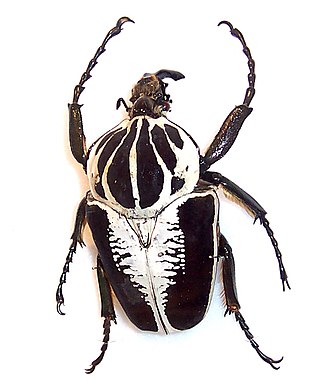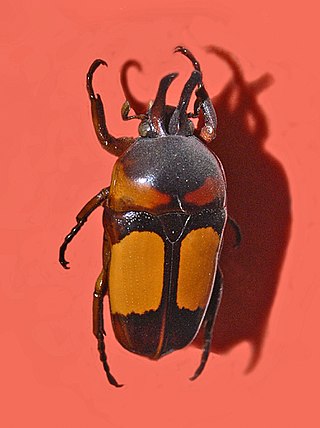
The Goliath beetles are any of the six species in the genus Goliathus. Goliath beetles are among the largest insects on Earth, if measured in terms of size, bulk and weight. They are members of subfamily Cetoniinae, within the family Scarabaeidae. Goliath beetles can be found in many of Africa's tropical forests, where they feed primarily on tree sap and fruit. Little appears to be known of the larval cycle in the wild, but in captivity, Goliathus beetles have been successfully reared from egg to adult using protein-rich foods such as commercial cat and dog food. Goliath beetles measure from 60–110 millimetres (2.4–4.3 in) for males and 50–80 millimetres (2.0–3.1 in) for females, as adults, and can reach weights of up to 80–100 grams (2.8–3.5 oz) in the larval stage, though the adults are only about half this weight. The females range from a dark chestnut brown to silky white, but the males are normally brown/white/black or black/white.

Dynastes satanas, the Satanas beetle, is a species of beetle belonging to the family Scarabaeidae. The name is sometimes misspelled as "satanus".

Stephanorrhina is a genus of the family Scarabaeidae, subfamily Cetoniinae and tribe Goliathini.

Blaesia atra is a beetle of the family Scarabaeidae and subfamily Cetoniinae.

Pseudochalcothea virens is a species of beetles of the family Scarabaeidae and subfamily Cetoniinae.

Lucanus laminifer is a species of beetles of the family Lucanidae.

Gnathocera trivittata is a species of beetles belonging to the family Scarabaeidae.

Gnathocera is a genus of beetles belonging to the family Scarabaeidae.

Gnathocera varians is a species of beetles belonging to the family Scarabaeidae.

Pachnoda impressa, the green and yellow fruit chafer, is a species of beetles of the family Scarabaeidae and subfamily Cetoniinae.

Pachnoda interrupta, commonly known as the sorghum chafer, is a species of beetle of the family Scarabaeidae and subfamily Cetoniinae.

Coilodera penicillata is a species of beetles belonging to the family Scarabaeidae, subfamily Cetoniinae.

Phaedimus cumingi is a beetle species belonging to the family Scarabaeidae, subfamily Cetoniinae.

Dicheros bicornis is a species of beetles belonging to the family Scarabaeidae, subfamily Cetoniinae.

Hoplopyga brasiliensis is a species of beetles of the family Scarabaeidae.

Phanaeus splendidulus is a species of beetles belonging to the family Scarabaeidae.

Chondrorrhina plana is a beetle belonging to the family Scarabaeidae.

Chondrorrhina mhondana is a species of beetle belonging to the family Scarabaeidae, subfamily Cetoniinae.

Rhamphorrhina bertolonii is a beetle belonging to the family Scarabaeidae. The species was first described by Hippolyte Lucas in 1879.

Leucocelis feana is a species of chafer beetles belonging to the family Scarabaeidae.



















